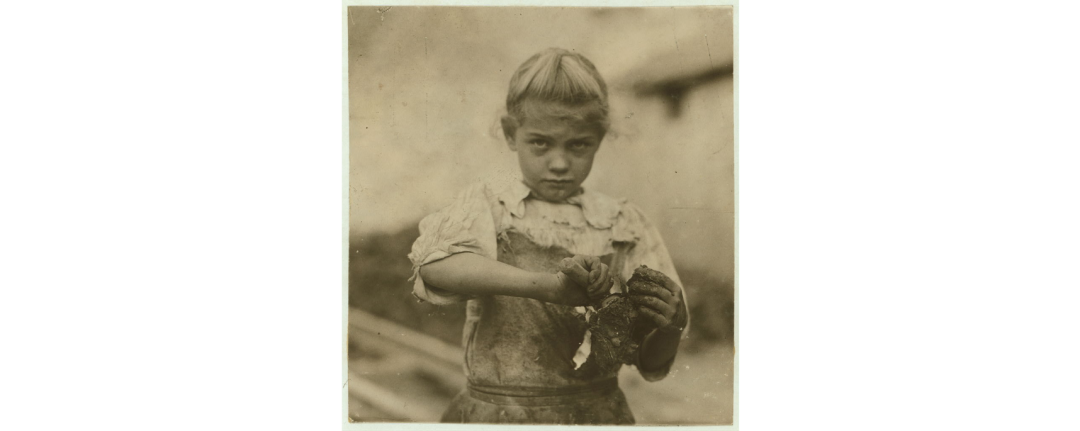The source presented here, at first glance, is a simple photograph of a child from the 1900s. This photograph was taken by photographer Lewis Wickes Hine in 1913. Hine was a photographer during the Progressive Era who was known for documenting the lives of the working-class people, especially children in America. According to Brian Ingrassia, author of the article titled, “Picturing class: Lewis W. Hine Photographs Child Labor in New England,” Hine dedicated a decade of his life to documenting child labor and to taking photographs for the National Child Labor Committee. He photographed children that were affected by this, “optimistically believing that his work’s cumulative weight would serve as a lever for change, acting as a catalyst for legislative reform of unjust social conditions” (Ingrassia 45).[1] During this time in his life, he took more than 5,000 photographs, depicting this issue within his work. Hine chooses not to title the photograph but gives a very detailed description as follows, “7-year old Rosie. Regular oyster. Her second year at it. Illiterate. Works all day. Shucks only a few pots a day.” After reading the description, it is understood that it is so much more than just a photograph of a child. This is intended to show and place emphasis on the unfair treatment of children during this time. The description makes it a very powerful piece.
Rosie is depicted unhappy, seemingly very rundown and overworked. She is depicted this way for a reason. Showing someone looking this way, especially a child, sparks so many emotions among the viewer of the photograph. Hine photographed this young girl this way for that reason exactly. He made powerful artistic choices, such as the way he captures the devastating emotions of a young girl who is being directly affected by the issue at hand; child labor. He makes these specific choices purposely and captures Rosie’s emotions in a way that sparks a sympathetic feeling in the viewer. He uses this strategy, hoping that this spark of emotions would potentially be enough to urge people to want to make a change. The photograph would not have such an intense impact if her emotions were not pictured in the way they were. Because he chooses to bring the emotional aspect into his piece, the message he was trying to convey about the injustices of child labor, become so much stronger. The work of Lewis Hine brings awareness to these issues that need to be resolved.
This issue of child labor was most prominent in the early 1900s, during the Progressive Era, when children frequently worked in factories as young as the age of 5. During this time, America was experiencing what was thought to be a crisis of democracy because of the urban industrial revolution. “The 1870 census found that 1 out of every 8 children was employed. This rate increased to more than 1 in 5 children by 1900” (Schuman 2).[2] They worked long, dangerous shifts for as long as 12 hours. The conditions were horrible and put these children into serious danger. There were very dangerous fumes, poisonous gases, chemicals, and mechanized equipment that could very easily be deadly to children so young. By the early 1900s, “the term “child labor” took on a very negative connotation for a growing number of adults. In 1910, while 20 percent of children from ten through fifteen years of age, and a majority of those in their late teens, continued to work fulltime for wages, the image of young Americans laboring for low pay in dangerous conditions became a symbol of the persistent injustices in the world’s largest capitalist democracy” (Lindenmeyer 134).[3] It was recognized by progressives that changes needed to be made to help the issues of child labor in unregulated mines and factories and miserable working conditions with low pay.
Progressives argued that children had rights too. The National Child Labor Committee, the organization in which Lewis Hine photographed for, pushed for laws that would ban the employment of children. In 1890, legislation to limit child labor as well create better working conditions was becoming the most significant reforms during the Progressive Era.[4] With the high demand for this change by all people during this time along with the help of people like Lewis Hine, who did what they could to support these changes, most states began to pass laws that would help the issue of child labor. Many state governments banned the hiring of children below a certain age while others limited the number of hours that children were allowed to work. “The 1938 Fair Labor Standards Act remains the foundation of child labor regulation in the United States” (Lindenmeyer 140).[5] In America today, there are still young people working for wages with the highest proportion of sixteen and seventeen-year-olds doing so than any other country but the unfair conditions have been diminished. Although the issue was not completely fixed by these laws, this was the start of change and resolution of child labor in the decades to come.
[1] B. M. Ingrassia, “Picturing class: Lewis W. Hine Photographs Child Labor in New England,” Historical Journal of Massachusetts (2017): 1.
[2] M. Schuman, “History of Child Labor in the United States-part 1: Little Children Working,” Monthly Labor Review (2017): 2.
[3] K. Lindenmeyer, “An Historical Perspective on Child Labor in the United States,” Employee Responsibilities and Rights Journal (2006): 134.
[4] Tindall, George Brown. Shi, David E, America: A Narrative History. (New York: W.W. Norton, 2000), 865.
[5] K. Lindenmeyer, “An Historical Perspective on Child Labor in the United States,” Employee Responsibilities and Rights Journal (2006): 140.
